La Crosse Technology M-15 OUTDOOR TRANSMITTER User Manual OMO M 15 User s Manual
La Crosse Technology Ltd. OUTDOOR TRANSMITTER OMO M 15 User s Manual
Users Manual
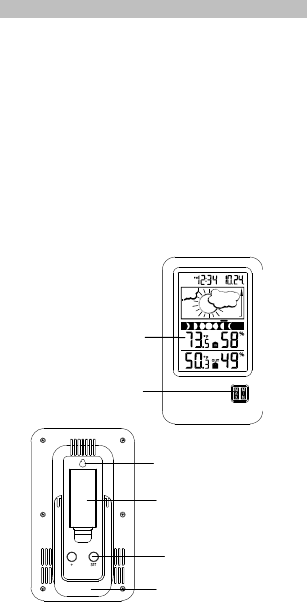
1
LCD
Display
Function key
Stand
Function keys
WEATHER STATION
Instruction Manual
INTRODUCTION:
Congratulations on purchasing this state-of-the-art
weather station as an example of innovative design and
quality piece of engineering. Providing radio controlled
time, calendar, weather forecast, moon phase, indoor and
outdoor temperature, indoor and outdoor relative humidity.
This unit will never keep you guessing on current and
future weather conditions. Operation of this product is
simple and straightforward. By reading this operating
manual, the user will receive a better understanding of the
Weather Station together with the optimum benefit of all its
features.
FEATURES:
The Weather Station
12/24 hour time display
Calendar display (year only in setting mode)
Display 8 Moon phases throughout the year
Battery
compartment
Hanging
hole

2
Weather forecasting with weather tendency indicator
Indoor and outdoor temperature display with
MIN/MAX records
Temperature display in ºC/ ºF
Indoor and outdoor humidity display
Humidity data display as RH%
Low battery indicator
Table standing or wall mounting
Thermo-Hygro Transmitter
Remote transmission of outdoor
temperature and humidity to weather
station by 915MHz
Wall mounting case
Mounting at a sheltered place. Avoid
direct rain and sunshine
TO INSTALL AND REPLACE BATTERIES IN THE
WEATHER STATION
The weather station uses 2 x AAA, IEC LR3, 1.5V
batteries. To install and replace the batteries, please follow
the steps below:
1. Insert finger or other solid
object in the space at the
bottom center of the
battery compartment and
lift up to remove the
cover.
2. Insert batteries observing
the correct polarity (see
marking).
3. Replace compartment
cover.
TO INSTALL AND REPLACE BATTERIES IN THE
THERMO-HYGRO TRANSMITTER
The outdoor thermo-hygro transmitter uses 2 x AAA, IEC
LR3, 1.5V batteries. To install and replace the batteries,
please follow the steps below:

3
1. Remove the battery cover.
2. Insert the batteries, observing the
correct polarity (see battery
compartment marking).
3. Replace the battery cover on the unit.
Note:
In the event of changing batteries in any of
the units, all units need to be reset by
following the setting up procedures. This is
due to a random security code assigned by
the transmitter at start-up. This code must be received and
stored by the weather station in the first 3 minutes of
power being supplied to the transmitter.
BATTERY CHANGE:
It is recommended to replace the batteries in all units on
an annual basis to ensure optimum accuracy of these
units.
Please participate in the preservation of
the environment. Return used batteries to
an authorized depot.
SETTING UP
1. First, insert the batteries in the transmitter (see “To
install and replace batteries in the thermo-hygro
transmitter” above).
2. Within 2 minutes of powering up the transmitter,
insert the batteries in the Temperature Station (see
“To install and replace batteries in the weather
station” above). Once the batteries are in place, all
segments of the LCD will light up briefly. Following
the indoor temperature/humidity and the time as
12:00 will be displayed. If these information are not
displayed on the LCD after 60 seconds, remove the
batteries and wait for at least 60 seconds before
reinserting them. Once the indoor data is displayed
user may proceed to the next step.
3. After the batteries are inserted, the weather station
will start receiving data signal from the transmitter.
The outdoor temperature and humidity data should
then be displayed on the weather station. If this
does not happen after 2 minutes, the batteries will
need to be removed from both units and reset from
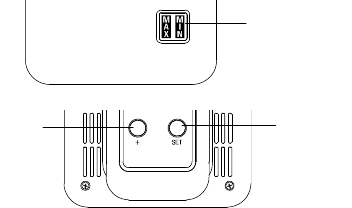
4
+ key
MIN/MAX key
SET key
step 1.
4. In order to ensure sufficient 915 MHz transmission
however, the distance between the Weather Station
and the transmitter should not be more than 330
feet (100 meters) (see notes on “Positioning” and
“915 MHz Reception”).
Note:
In the event of changing batteries of the units, ensure the
batteries do not spring free from the contacts. Always wait
at least 1 minute after removing the batteries before
reinserting, otherwise start up and transmission problems
may occur.
FUNCTION KEYS:
Weather Station:
The Weather Station has 3 easy to use function keys: 1
key on the front, and 2 keys on the back
SET key
Press and hold the key to enter manual setting
modes: manual time setting, and calendar
+ key
Increase, change, toggle all values in manual set
mode
MIN/MAX key
Press shortly to toggle between indoor and outdoor
MAX/MIN temperature and current temperature
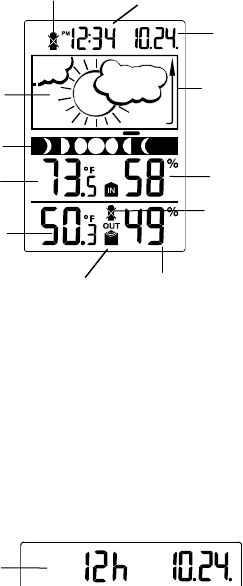
5
Moon
phase
icon
Weather
tendency
indicator
Calendar
Indoor
relative
humidity
in RH%
Indoo
r
temperature
in ºC/ºF
Weathe
r
forecast icon
Outdoor data signal
reception indicator*
Outdoo
r
temperature
in ºC/ºF
Outdoor relative
humidity in RH%
Time
LCD SCREEN
The LCD screen is split into 5 sections displaying the
information for time/calendar, weather forecast, moon
phase, indoor data, and outdoor data.
* When the signal is successfully received by the weather
station, the outdoor transmission icon will be switched on.
(If not successful, the icon will not be shown on LCD). The
user can then easily see whether the last reception was
successful (icon on) or not (icon off).
MANUAL SETTINGS:
The following manual settings can be changed when
pressing the SET key for:
12/24 time display setting
Manual time setting
Calendar setting
ºF/ºC temperature display setting
12/24 HOUR TIME DISPLAY SETTING
Low battery indicator
(weather station)
Low battery
indicator
(transmitter)
flashing
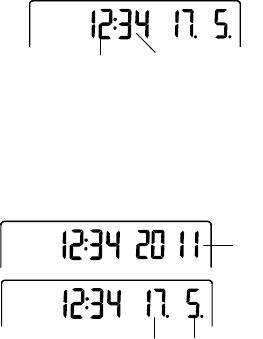
6
To set the time format in 12h or 24h display:
1. “12h” or “24h” will start flashing. (default 12h)
2. Press the + key to select the “12h” or “24h” display
mode.
3. Confirm with the SET key and enter the “Manual
time setting”.
Note:
When 12h mode display is selected, the calendar format
will be "Month. Day" display. When 24h mode display is
selected, the calendar format will be "Day. Month" display.
MANUAL TIME SETTING:
To set the time.
1. The hour digit will start flashing.
2. Use the + key to set the hour.
3. Press again the SET key to set the minutes. The
minute digits start flashing.
4. Use the + key to set the minutes.
5. Confirm with the SET key and enter the Calendar
setting.
CALENDAR SETTING:
The date default of the weather station is 1. 1. 2011.
To set the calendar:
1. The year starts flashing.
2. Use the + key to set the year (between year 2011-
2039).
Hour flashing Minutes flashing
Year
Date and month
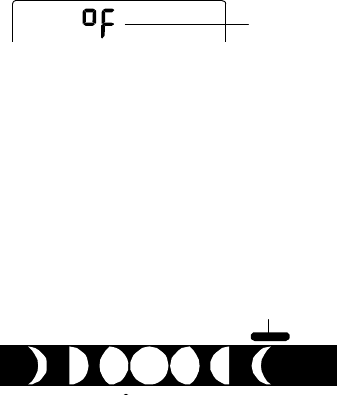
7
3. Press the SET key again to confirm and to enter the
month setting. The month starts flashing.
4. Use the + key to set the month.
5. Press the SET key again to confirm and to enter the
date setting mode. The date starts flashing.
6. Use the + key to set the date.
7. Confirm all calendar settings with the SET key and
“ºF/ºC temperature display setting”.
°F/°C TEMPERATURE UNIT SETTING
The default temperature display is set to °F (degree
Fahrenheit). To select °C (degree Celsius):
1. The “°F or C” will start flashing,
2. Use the + key to toggle between “°C” and “°F”.
3. Once the desired temperature unit has been chosen,
confirm with the SET key and exit the setting mode.
TO EXIT THE MANUAL SETTING MODE
To exit the manual setting mode anytime during the
manual setting, wait for automatic timeout. The mode will
return to normal time display.
MOON PHASES SYMBOL
The moon icon of the weather station will also display all 8
moon phases throughout the year according to the set
calendar. A bar segment above the moon phase will
indicate current moon phase.
New
Moon
Waning
Crescent
First
Quarter Waxing
Gibbous
Waxing
Crescent
Last
Quarter
Full
Moon Waning
Gibbous
Bar segment (moon phase indicator)
flashing

8
WEATHER FORECAST AND WEATHER
TENDENCY:
WEATHER FORECASTING ICONS:
The weather icons in the second section of LCD can be
displayed in any of the following combinations:
Sunny Cloudy with sunny intervals Rainy
For every sudden or significant change in the air pressure,
the weather icons will update accordingly to represent the
change in weather. If the icons do not change, then it
means either the air pressure has not changed or the
change has been too slow for the Weather station to
register. However, if the icon displayed is a sun or raining
cloud, there will be no change of icon if the weather gets
any better (with sunny icon) or worse (with rainy icon)
since the icons are already at their extremes.
The icons displayed forecasts the weather in terms of
getting better or worse and not necessarily sunny or rainy
as each icon indicates. For example, if the current weather
is cloudy and the rainy icon is displayed, it does not mean
that the product is faulty because it is not raining. It simply
means that the air pressure has dropped and the weather
is expected to get worse but not necessarily rainy.
Note:
After setting up, readings for weather forecasts should be
disregarded for the next 12-24 hours. This will allow
sufficient time for the Weather station to collect air
pressure data at a constant altitude and therefore result in
a more accurate forecast.
Common to weather forecasting, absolute accuracy
cannot be guaranteed. The weather forecasting feature is
estimated to have an accuracy level of about 75% due to
the varying areas the Weather station has been designed
for use. In areas that experience sudden changes in
weather (for example from sunny to rain), the Weather
station will be more accurate compared to use in areas
where the weather is stagnant most of the time (for
example mostly sunny).

9
Indoor
relative
humidity
in RH%
Indoo
r
temperature
in ºC/ºF
If the weather station is moved to another location
significantly higher or lower than its initial standing point
(for example from the ground floor to the upper floors of a
house), discard the weather forecast for the next 12-24
hours. By doing this, the Weather Station will not mistake
the new location as being a possible change in air-
pressure when really it is due to the slight change of
altitude.
WEATHER TENDENCY INDICATOR
Working together with the weather icons is the weather
tendency indicators (located on the left and right sides of
the weather icons). When the indicator points upwards, it
means that the air-pressure is increasing and the weather
is expected to improve, but when indicator points
downwards, the air-pressure is dropping and the weather
is expected to become worse.
Taking this into account, one can see how the weather has
changed and is expected to change. For example, if the
indicator is pointing downwards together with cloud and
sun icons, then the last noticeable change in the weather
was when it was sunny (the sun icon only). Therefore, the
next change in the weather will be cloud with rain icons
since the indicator is pointing downwards.
Note:
Once the weather tendency indicator has registered a
change in air pressure, it will remain permanently
visualized on the LCD.
INDOOR TEMPERATURE/HUMIDITY DATA
The indoor temperature and humidity data are
automatically updated and displayed on the fourth section
of the LCD.
OUTDOOR TEMPERATURE/HUMIDITY DATA
The last LCD section shows the outdoor temperature and
humidity, and the reception indicator.

10
Outdoor data signal
reception indicator
Outdoo
r
temperature
in ºC/ºF
Outdoor relative
humidity in RH%
TOGGLING AND RESETTING THE MIN/MAX DATA
TO VIEW THE MIN/MAX DATA
Press the MIN/MAX key several times to view the
MIN/MAX indoor temperature, and MIN/MAX outdoor
temperature sequentially.
TO RESET THE MIN/MAX DATA
Press and hold MIN/MAX key for 3 seconds to reset all
the indoor and outdoor temperature to current
temperatures.
LOW BATTERY INDICATOR
Low battery indicator is displayed on the LCD when the
batteries require changing.
ABOUT THE THERMO-HYGRO TRANSMITTER
The range of the thermo-hygro transmitter may be affected
by the temperature. At cold temperatures the transmitting
distance may be decreased. Please bear this in mind
when positioning the transmitters. Also the batteries may
be reduced in power for the thermo-hygro transmitter.
CHECKING FOR 915MHz RECEPTION
If the outdoor temperature and humidity data are not being
received within three minutes after setting up (or outdoor
display always show “- -.-” in the outdoor section of the
Weather station during normal operation), please check
the following points:
1. The distance of the weather station or transmitters
should be at least 5 to 6.5 feet (1.5 -2 meters) away
from any interfering sources such as computer
monitors or TV sets.
2. Avoid placing the transmitters onto or in the
immediate proximity of metal window frames.
3. Using other electrical products such as headphones
or speakers operating on the 915MHz-signal
Low battery
indicator
(transmitter)

11
frequency may prevent correct signal transmission
or reception.
4. Neighbors using electrical devices operating on the
915MHz-signal frequency can also cause
interference.
Note:
When the 915MHz signal is received correctly, do not re-
open the battery cover of either the transmitter or weather
station, as the batteries may spring free from the contacts
and force a false reset. Should this happen accidentally
then reset all units (see “Setting up” above) otherwise
transmission problems may occur.
The transmission range is around 330 feet (100 meters)
from the thermo-hygro transmitter to the weather station
(in open space). However, this depends on the
surrounding environment and interference levels. If no
reception is possible despite the observation of these
factors, all system units have to be reset (see “Setting
up” above).
POSITIONING THE WEATHER STATION
The weather station provides the option of table standing
or wall mounting the unit. Before wall mounting, please
check that the outdoor data can be received from the
desired locations.
To wall mount:
1. Fix a screw (not supplied) into the
desired wall, leaving the head
extended out by about 5mm.
2. Place the weather station onto
the screw, using the hanging hole
on the backside. Gently pull the
weather station down to lock the
screw into place.
Foldout table stand:
The foldout table stand leg is located
on the backside. Pull the stand out
from the bottom center edge of the
weather station, below the battery
compartment. Once the foldout table
stand is extended, place the weather
station in an appropriate location.

12
POSITIONING THE THERMO-HYGRO
TRANSMITTER
Mounting at a sheltered place. Avoid direct
rain and sunshine.
The thermo-hygro transmitter can be placed
onto any flat surface or wall mount using the
bracket which doubles as a stand or wall
mount base.
To wall mount:
1. Secure the bracket onto a desired wall
using the screws and plastic anchors.
2. Clip the transmitter onto the bracket.
Note:
Before permanently fixing the thermo-hygro to
the wall base, pace all units in the desired
locations to check that the outdoor temperature
and humidity readings are receivable. In event that the
signal is not received, relocate the thermo-hygro
transmitter or the weather station slightly as this may help
the signal reception.
CARE AND MAINTENANCE:
Extreme temperatures, vibration and shock should
be avoided as these may cause damage to the units
and give inaccurate forecasts and readings.
When cleaning the display and casings, use a soft
damp cloth only. Do not use solvents or scouring
agents as they may mark the LCD and casings.
Do not submerge the units in water.
Immediately remove all low powered batteries to
avoid leakage and damage. Replace only with new
batteries of the recommended type.
Do not make any repair attempts to the units. Return
it to their original point of purchase for repair by a
qualified engineer. Opening and tampering with the
units may invalidate their guarantee.
Do not expose the units to extreme and sudden
temperature changes, this may lead to rapid
changes in forecasts and readings and thereby
reduce their accuracy.
13
SPECIFICATIONS:
Temperature measuring range:
Indoor : 14.1°F to +139.8°F with 0.2°F resolution
-9.9ºC to +59.9ºC with 0.1°C resolution
(“OF.L” displayed if outside this range)
Outdoor : -39.8°F to +139.8°F with 0.2°F resolution
-39.9ºC to +59.9ºC with 0.1°C resolution
(“OF.L” displayed if outside this range)
Indoor humidity range : 20% to 95% with 1% resolution
(Display “- -“ if temperature is OL.F; display “19%“ if < 20%
and “96%” if > 95%)
Outdoor humidity range : 1% to 99% with 1% resolution
(Display “- -“ if outside temperature is OF.L; display 1% if <
1% and 99% if > 99%)
Data checking intervals
Indoor temperature : every 16 seconds
Indoor humidity : every 64 seconds
Outdoor temperature and humidity: every 4 seconds
Transmission range : up to 100 meters (open space)
Power consumption (alkaline batteries recommended):
Weather station : 2 x AAA, IEC LR3, 1.5V
Thermo-hygro transmitter : 2 x AAA, IEC LR3, 1.5V
Battery life : up to 24 months
Dimensions (L x W x H):
Weather station : 3.72” x 0.78” x 6.18”
94.6 x 20 x 157mm
Thermo-hygro transmitter : 1.41” x 0.62” x 4.03”
36 x 16 x 102.6mm
WARRANTY INFORMATION
La Crosse Technology, Ltd provides a 1-year limited
warranty on this product against manufacturing defects in
materials and workmanship.
This limited warranty begins on the original date of
purchase, is valid only on products purchased and used in
North America and only to the original purchaser of this
product. To receive warranty service, the purchaser must
contact La Crosse Technology, Ltd for problem
determination and service procedures. Warranty service
can only be performed by a La Crosse Technology, Ltd
authorized service center. The original dated bill of sale
must be presented upon request as proof of purchase to
La Crosse Technology, Ltd or La Crosse Technology,
Ltd’s authorized service center.
14
La Crosse Technology, Ltd will repair or replace this
product, at our option and at no charge as stipulated
herein, with new or reconditioned parts or products if found
to be defective during the limited warranty period specified
above. All replaced parts and products become the
property of La Crosse Technology, Ltd and must be
returned to La Crosse Technology, Ltd.
Replacement parts and products assume the remaining
original warranty, or ninety (90) days, whichever is
longer. La Crosse Technology, Ltd will pay all expenses
for labor and materials for all repairs covered by this
warranty. If necessary repairs are not covered by this
warranty, or if a product is examined which is not in need
or repair, you will be charged for the repairs or
examination.
The owner must pay any shipping charges incurred in
getting your La Crosse Technology, Ltd product to a La
Crosse Technology, Ltd authorized service center.
Your La Crosse Technology, Ltd warranty covers all
defects in material and workmanship with the following
specified exceptions: (1) damage caused by accident,
unreasonable use or neglect (including the lack of
reasonable and necessary maintenance); (2) damage
occurring during shipment (claims must be presented to
the carrier); (3) damage to, or deterioration of, any
accessory or decorative surface; (4) damage resulting
from failure to follow instructions contained in your
owner’s manual; (5) damage resulting from the
performance of repairs or alterations by someone other
than an authorized La Crosse Technology, Ltd authorized
service center; (6) units used for other than home use (7)
applications and uses that this product was not intended or
(8) the products inability to receive a signal due to any
source of interference.
This warranty covers only actual defects within the product
itself, and does not cover the cost of installation or removal
from a fixed installation, normal set-up or adjustments,
claims based on misrepresentation by the seller or
performance variations resulting from installation-related
circumstances.
LA CROSSE TECHNOLOGY, LTD WILL NOT ASSUME
LIABILITY FOR INCIDENTAL, CONSEQUENTIAL,

15
PUNITIVE, OR OTHER SIMILAR DAMAGES
ASSOCIATED WITH THE OPERATION OR
MALFUNCTION OF THIS PRODUCT. THIS PRODUCT
IS NOT TO BE USED FOR MEDICAL PURPOSES OR
FOR PUBLIC INFORMATION. THIS PRODUCT IS NOT
A TOY. KEEP OUT OF CHILDREN’S REACH.
This warranty gives you specific legal rights. You may
also have other rights specific to your State. Some States
do no allow the exclusion of consequential or incidental
damages therefore the above exclusion of limitation may
not apply to you.
For warranty work, technical support, or information
contact:
La Crosse Technology
2817 Losey Blvd. S.
La Crosse, WI 54601
www.lacrossetechnology.com/9060
All rights reserved. This handbook must not be reproduced in any
form, even in excerpts, or duplicated or processed using electronic,
mechanical or chemical procedures without written permission of the
publisher.
This handbook may contain mistakes and printing errors. The
information in this handbook is regularly checked and corrections
made in the next issue. We accept no liability for technical mistakes
or printing errors, or their consequences.
All trademarks and patents are acknowledged.
16
FCC ID: OMO-M-15 (transmitter)
FCC DISCLAIMER
RF Exposure mobile:
The internal / external antennas used for this mobile transmitter
must provide a separation distance of at least 20 cm (8 inches)
from all persons and must not be co-located or operating in
conjunction with any other antenna or transmitter."
Statement according to FCC part 15.19:
This device complies with Part 15 of the FCC Rules. Operation
is subject to the following two conditions: (1) this device may
not cause harmful interference, and (2) this device must accept
any interference received, including interference that may
cause undesired operation.
Statement according to FCC part 15.21:
Modifications not expressly approved by this company could
void the user's authority to operate the equipment.
Statement according to FCC part 15.105:
NOTE: This equipment has been tested and found to comply
with the limits for a Class B digital device, pursuant to Part 15
of the FCC Rules. These limits are designed to provide
reasonable protection against harmful interference in a
residential installation. This equipment generates, uses and can
radiate radio frequency energy and, if not installed and used in
accordance with the instructions, may cause harmful
interference to radio communications.
However, there is no guarantee that interference will not occur
in a particular installation. If this equipment does cause harmful
interference to radio or television reception, which can be
determined by turning the equipment off and on, the user is
encouraged to try to correct the interference by one or more of
the following measures:
Reorient or relocate the receiving antenna.
Increase the separation between the equipment and
receiver.
Connect the equipment into an outlet on a circuit
different from that to which the receiver is connected.
Consult the dealer or an experienced radio/TV
technician for help.